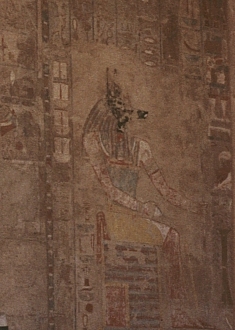Egyptian Goddess Isis
Travel The World

Anubis is the Greek name for the ancient god in Egyptian mythology whose hieroglyphic is more accurately spelt Anpu (also Anup, Anupu, Wip, Ienpw, Inepu, Yinepu, or Inpw). He is also known as Sekhem Em Pet. Prayers to Anubis have been found carved on the most ancient tombs in Egypt; indeed, the Unas text (line 70) associates him with the Eye of Horus. Anubis is the ruler of the underworld.
Originally, in the Ogdoad system, he was god of the underworld, and his name is frequently thought to have reflected this, meaning something like putrefaction. He was said to have a wife, Anput (who was really just his female aspect, her name being his with an additional feminine suffix: the t), who was depicted exactly the same, though feminine. His father was originally said to be Ra, as he was the creator god, and thus his mother was said to be Hesat, Ra's wife, who later was identified as Hathor (to whom her identity was remarkably similar). As lord of the underworld, Anubis was identified as the father of Kebechet, the goddess of the purification of bodily organs due to be placed in canopic jars during mummification.
Following the merging of the Ennead and Ogdoad belief systems, as a result of the identification of Atum with Ra, and their compatibility, Anubis became considered a lesser god in the underworld, giving way to the more popular Osiris. Indeed, when the Legend of Osiris and Isis emerged, it was said that when Osiris had died, Anubis stood down from his position out of respect for Osiris.
Since he had been more associated with beliefs about the weighing of the heart than had Osiris, Anubis retained this aspect, and became considered more the gatekeeper of the underworld, the Guardian of the veil (of death). As such, he was said to protect souls as they journeyed there, and thus be the patron of lost souls (and consequently orphans). Rather than god of death, he had become god of dying, and consequently funeral arrangements. It was as the god of dying that his identity merged with that of Wepwawet, a similar jackal-headed god, associated with funerary practice, who had been worshipped in Upper Egypt, whereas Anubis' cult had centred in Lower Egypt.
As one of the most important funerary rites in Egypt involved the process of embalming, so it was that Anubis became the god of embalming, in the process gaining titles such as He who belongs to the mummy wrappings, and He who is before the divine [embalming] booth. High priests often wore the Anubis mask to perform the ceremonial deeds of embalming. It also became said, frequently in the Book of the dead, that it had been Anubis who embalmed the dead body of Osiris, with the assistance of the other main funerary deities involved - Nepthys, and Isis.
Having become god of embalming, Anubis became strongly associated with the (currently) mysterious and ancient imiut fetish, present during funerary rites, and Bast, who by this time was goddess of ointment, initially became thought of as his mother.
However, as lesser of the two gods of the underworld, he gradually became considered the son of Osiris, but Osiris' wife, Isis, was not considered his mother, since she too inappropriately was associated with life. Instead, his mother became considered to be Nepthys, who had become strongly associated with funerary practice, indeed had in some ways become the personification of mourning, and was said to supply bandages to the deceased.
Subsequently, this apparent infidelity of Osiris was explained in myth, in which it was said that a sexually frustrated Nepthys had disguised herself as Isis in order to appeal to her husband, Set, but he did not notice her as he was gay and infertile, whereas Isis' husband Osiris did, mistaking her for his wife, which resulted in Anubis' birth. Some more homophobic versions of the myth depict Set as the father.
In later times, during the Ptolemaic period, as their functions were similar, Anubis was identified as the Greek god Hermes, becoming Hermanubis. The centre of this cult was in uten-ha/Sa-ka/Cynopolis, a place whose Greek name simply means city of dogs. In Book xi of The Golden Ass by Apuleius, we find evidence that the worship of this god was maintained in Rome at least up to the 2nd century. Indeed, Hermanubis also appears in the alchemical and hermetical literature of the Middle Ages and the Renaissance.